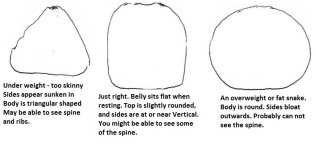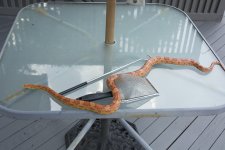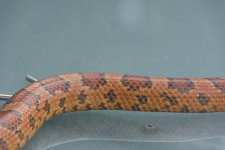I'm on the fence about getting babies to grow fast. I've heard of people who feed every few days, which I feel is probably too much, but I feel a 5 day feeding schedule is fine.
Some people feel that is power feeding.
My feedings are not consistently every 5 days or every 7 days, etc, due to my schedule.
It is also partially intentional, because snakes in the wild do not feed on a set schedule, and sometimes their meals are closer together, sometimes further apart, when they find food.
My babies are all fed on the same schedule (aside from during shed process) and I have had babies form the same clutch grow at drastically different rates. Some would be on hoppers, while some would be at adult mouse size, all fed on the same schedule.
That said, (IMO) babies in the wild are going to want to eat and grow fast, because the longer they stay small, the higher risk they are at becoming a meal for another animal.
I'm more conservative in feeding, for the most part. I do periodically ramp up feeding (every 5 or 6 days usually, on occasion it might be 4 days in between a feeding, but not often), but overall, I usually feed about ever 7 days for most, and spread out every 2-3 weeks on adult males.
My Irian Jaya male usually gets fed every 2-3 weeks. He gets small/medium rats sometimes, and a couple large adult mice other times.
I do have a friend who does believe that "power feeding" can lead to unhealthy snakes and early death. He works with mostly Carpet Pythons, and on some that have died early, he has done a necropsy, and they have been power fed, and have heavy fat deposits. He choses to feed conservatively.
My thought on that is due to being fed rats. In the wild, many of the Carpet Pythons often feed on lower fat prey, like birds, and I think a consistent diet of captive bred rats leads to unhealthy snakes. (Which is why I alternate with mice on my IJ, and my Granite IJ that is on breeder loan gets ASF's or mice and not regular rats.) It is also why I never feed rats to my Cornsnakes or Kingsnakes.
I think a variety of prey would be healthiest, and while I am out of stock, I have offered baby chicks and quail to some of my snakes on occasion.
In reference to this post, I have not seen any current photos of Tango, so I cannot say whether he is overweight or just further in growth for his age. I have seen 800-900 gram Cornsnakes that were not at all overweight, just large.
Edit to add: In THIS thread, from less than a month ago, when you first got Tango, he does not look overweight to me. He looks like he's got that "loaf of bread" shape that they are supposed to. The photo of him in the enclosure, his belly looks flat, which is not overweight.



